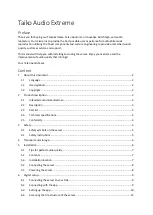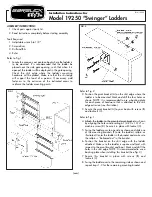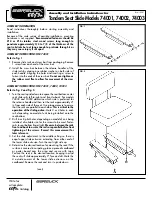
Installation and Operational Instructions for
EAS
®
-Compact
®
overload clutch,
Type 49_._ _4._ Sizes 4 and 5
(B.4.14.6.GB)
25/01/2013 GC/NH/GH/SU
Chr. Mayr GmbH + Co. KG
Tel.: +49 8341 804-0
Eichenstraße 1
Fax: +49 8341 804-421
D-87665 Mauerstetten
www.mayr.com
Page
14
of
21
Germany
E-Mail:
Torque Adjustment
The torque is set manufacturer-side according to the customer's
request.
If no particular torque adjustment is requested customer-side,
the clutch will always be
pre-set
to approx. 70 % of the
maximum torque. The adjusting nut (7) is marked with dimension
"a" (70% of the maximum torque, see Fig. 18).
Adjustment takes place via dimension "a" by turning the set
screws (Item 7.2, Fig. 18).
The adjusting nut (7) remains turned in flush position with the
hub (1).
The installed cup springs (11) are operated in the negative range
of the characteristic curve (see Fig. 19); this means that a
stronger pre-tensioning of the cup springs results in a decrease
of the spring force.
Turning the set screws (7.2) clockwise causes
a reduction in torque (Fig. 19, dimension "a -"
acc. Adjustment Table (Item 15) and Fig. 20).
Turning it anti-clockwise causes the torque to
increase (Fig. 19, dimension "a +" acc.
Adjustment Table (Item 15) and Fig. 20).
You should be facing the adjusting nut (7) as
shown in Fig. 18.
Changing the Torque
The torque is changed exclusively via the set
screws (7.2) and not via the adjusting nut (7).
a) Loosen all hexagon nuts (6 pieces, Item 7.3).
b) For dimension "a", see the Adjustment Table (Item 15, Fig.
20) (The Adjustment Table (15) is glued onto the outer
diameter of the adjusting nut (7), see Fig. 18).
c) Adjust all set screws (6 pieces, Item 7.2) evenly to the
required dimension "a" using a hexagon socket wrench,
wrench opening 6.
d) Counter (secure) the set screws (6 pieces, Item 7.2) again
with hexagon nuts (7.3).
Adjusting the adjusting nut (7) or distorting the
cup springs (11) out of the cup spring
characteristic curve (see Fig. 19) stops the
clutch functioning.
The inspection dimension "a" (markings on
adjusting nut) can show deviations due to construction
tolerances or to clutch wear. After de-installing the clutch (e.g.
due to cup spring replacement or changes to the cup spring
layering), the clutch must be re-adjusted and calibrated using
dimension "a" (acc. markings on the adjusting nut and the
Adjustment Table).
Fig. 18
The adjusting nut (Item 7) is marked with
dimension "a" (70% of the maximum torque).
The adjusting nut (7) is turned in flush position
with the hub (1).
Fig. 19
Dimension "a"
Facing direction
7
7.3
7.2
11
15
1
a –
a +
Move to
operational range
F
o
rc
e
F
Graph of
spring characteristic
curve
Operational
range
Spring path S







































